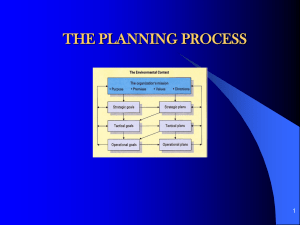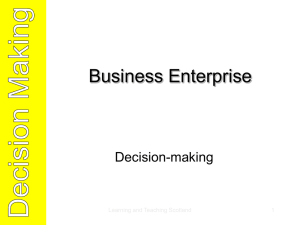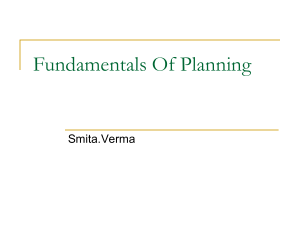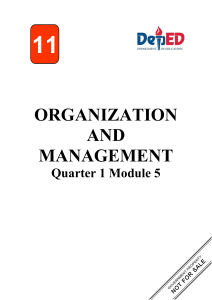the planning process
advertisement
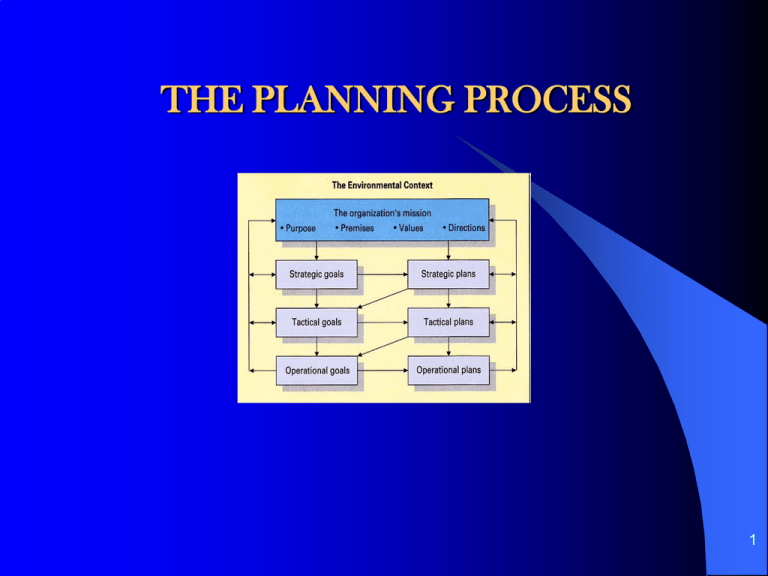
THE PLANNING PROCESS 1 Strategic Planning SWOT Analysis Internal Factors Strengths (S) Weaknesses (W) External Factors Opportunities (O) Threats (T) SO Strategy (Maxi-Maxi): WO Strategy (Mini-Maxi): Use strengths to maximize opportunities Minimize weaknesses using opportunities ST Strategy (Maxi-Min): WT Strategy (Mini-Mini): Use strengths to minimize threats Try to minimize weaknesses and threats through restructuring,, creating joint ventures, etc. 2 COMPANY STRATEGIES Strategy of unique product Strategy of diversification 3 PRODUCT STRATEGIES Porter Strategies Strategy Type Definition Examples Differentiation Distinguish products or services Rolex (watches) Mercedes-Benz (automobiles) Nikon (cameras) Cross (writing instruments) Hewlett - Packard (calculators) Overall cost leadership Reduce manufacturing and other costs Timex Hyundai Kodak BIC Texas Instruments Focus Concentrate on specific regional market, product market or group of buyers Longines Fiat, Alfa Romeo Polaroid Waterman Pens Fisher Price 4 PRODUCT STRATEGIES Miles and Snow Strategies Strategy Type Prospector Defender Definition Innovative and growth oriented, searches for new markets and new growth opportunities, encourages risk taking Examples 3M Protects current markets, maintains stable growth, serves current customers BIC Analyzer Maintain current markets and current customer satisfaction with moderate emphasis on innovation IBM Reactor No clear strategy, reacts to changes in the environment International Harvester W.T. Grant 5 TACTICAL PLANNING STEP 1 – Establish tactical goals: to be established at each departmental level, starting from the strategic goals, to realize strategic plans STEP 2 – Developing tactical plans: establish future actions, timing and necessary resources 6 OPERATIONAL PLANNING STEP 1 – Establish operational goals: to be established at each operational level from the department, starting from the tactical goals, to realize tactical plans STEP 2 – Developing operational plans: establish future actions, timing and necessary resources 7 TYPES OF OPERATIONAL PLANS Plan Single-use plans Description Developed to carry out a course of action not likely to be carried out in the future - Program Single-use plan for a large set of activities - Project Single-use plan of less scope and complexity than a program Standing plans Developed for activities that recur regularly over a period of time - Policy Standing plan specifying the organization’s general response to a designated problem or situation - Standard operating procedure Standing plan outlining steps to be followed in particular circumstances - Rules and regulations Standing plans describing exactly how specific activities are to be carried out 8 BUSINESS PLAN Executive Summary 1. Business description: a brief description of the product or service proposed to be realized and the perspectives for the next 5-10 years 2. Strategic planning: present the concrete activities to reach the long term objectives, taking into account the stage of your product 3. The market: a brief description of the targeted market segments and of the penetration channels and, also, present the utility product for the final consumer 4. Conducerea companiei: present the company management system and the responsibilities of each manager 5. Financial aspects: show estimated sales and profits for the next 5 years, the involved costs and how much represent your contribution 9 Business plan – The content A. The Purpose of Company B. The Objectives C. The Market Analysis D. The production process E. The marketing strategies F. The financial planning G. The company organization and Management H. The ownership form of business I. The critical risks and problems J. Summary and Conclusions Appendices 10
